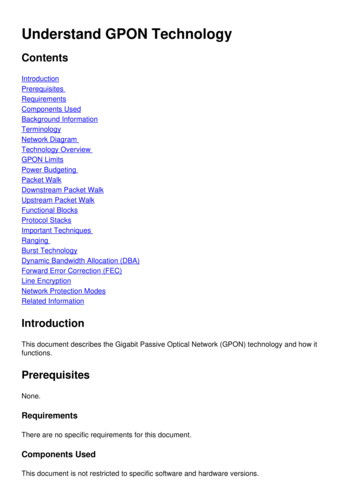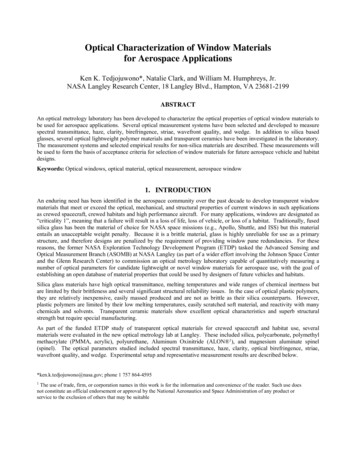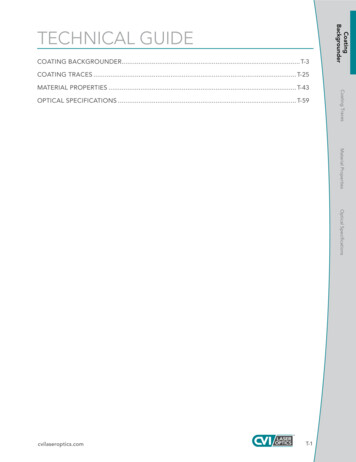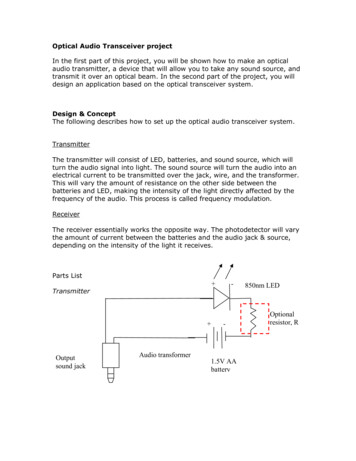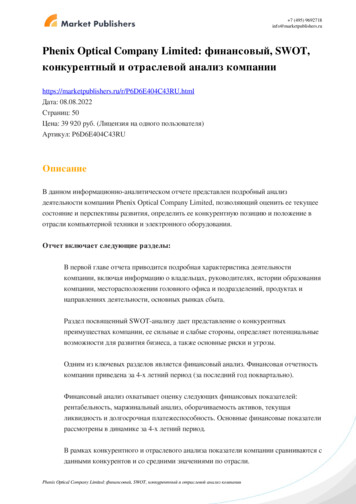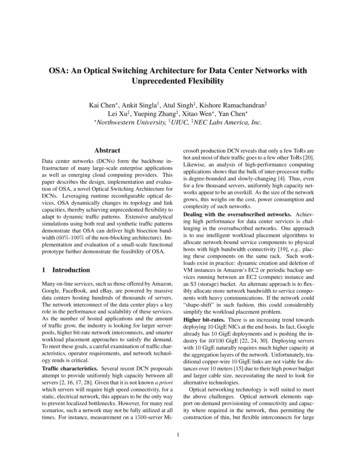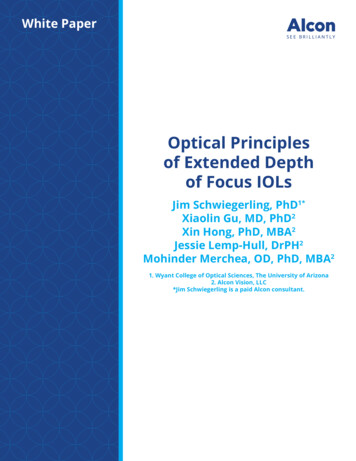
Transcription
White PaperOptical Principlesof Extended Depthof Focus IOLsJim Schwiegerling, PhD1*Xiaolin Gu, MD, PhD2Xin Hong, PhD, MBA2Jessie Lemp-Hull, DrPH2Mohinder Merchea, OD, PhD, MBA21. Wyant College of Optical Sciences, The University of Arizona2. Alcon Vision, LLC*Jim Schwiegerling is a paid Alcon consultant.
Key Takeaways Depth of focus extension elongates the focal region to provide a continuous range of vision fromdistance to intermediate, with some functional performance at near. Small aperture IOLs increase the depth of focus of the eye, but dramatically reduce the amount oflight entering the eye, and consequently are typically only implanted monocularly. Low add diffractive multifocal IOLs can provide similar acuity to extended depth of focus lenses,but are associated with the same visual disturbances, like halos, that are associated with alldiffractive lenses. Wavefront shaping, a next generation optical principle, such as X-WAVE Technology, providesdepth of focus extension that utilizes all of the light entering the eye while simultaneously reducingthe halos and artifacts associated with diffractive lenses.IntroductionDepth of focus extension is the desire to create sharp images over a continuous range of distances.Photographers are well acquainted with extending depth of focus. For example, when photographinga companion at the Grand Canyon, if the camera is focused on the canyon, then the subject is blurred.If the camera is focused on the subject, then the canyon is blurred. Photographers have learned toextend depth of focus by “stopping down” the aperture, that is making the pupil of the camera lenssmaller. The smaller pupil now enables the subject and the canyon to be in focus simultaneously, butless light is entering the camera. Less light might be fine under bright lighting conditions, but mayaffect image quality under dimmer conditions.In treating pseudophakic presbyopia, depth of focus extension is desirable. Creating an implantwith the ability to create sharp images over the continuous range from distance to intermediate,and possibly even into the near vision region could dramatically reduce spectacle dependence andenable a flexible lifestyle for the patient. A variety of techniques have been tried to provide depthof focus extension in intraocular lenses (IOLs). The photographer’s technique of stopping down theaperture, as well as techniques such as increasing the spherical aberration of the eye and using lowadd multifocal diffractive lenses have all been implemented. Each of these techniques have visualquality compromises associated with them. Wavefront shaping in IOLs is a next generation opticaltechnology that can provide high quality depth of focus extension. Alcon’s X-WAVE technology isthe first example of this technology in an IOL. Here, an overview of various depth of focus extensiontechniques is provided to illustrate their potential and differences.The Ideal Extended Depth of Focus LensPrior to reviewing the properties of available Extended Depth of Focus (EDOF) lenses, it is useful tounderstand the properties of an ideal EDOF lens. While such lenses are physically impossible due tothe limitations of the properties of light, this exercise is useful since as EDOF technology evolves, itshould converge towards the ideal solution. Figure 1 compares the imaging properties of a monofocallens to the desired properties of an ideal EDOF lens. For a monofocal lens viewing a distant object, thelight is focused by the lens to a sharp point on the retina. Each point in the distant object is focusedto a point on the retina, creating a crisp image. As objects come closer to the eye, the focal spot shiftsfurther behind the retina. Instead of a sharp point on the retina, a blur circle is created. The closer theobject, the bigger the blur circle. This leads to objects appearing progressively blurred as they comecloser to the eye. The ideal EDOF lens would concentrate light down to a point, but then this pointwould remain focused over an extended range. In effect, the ideal EDOF lens concentrates the light toa line along the visual axis. Such a lens would then create a sharp image for distant objects. For nearobjects, the focal pattern again shifts behind the retina, but the light from the near object remains infocus on the retina. Furthermore, all objects in the range from distance to near would be in focus.
Figure 1: For distant objects, a monofocal lens focuses light to a sharp point on the retina.When looking at near objects, this focal point shifts behind the retina, leading to a large bluron the retina. The ideal EDOF lens would cause light to converge to a line, with one end of theline being on the retina for distant objects. When viewing near objects, the focal pattern againshifts, but the other end of the line is now on the retina. This ideal case would mean all objectsfrom distance to near would be in focus simultaneously on the retina.Unfortunately, the laws of physics preclude the creation of the ideal EDOF lens, but if the strictrequirements of the line focus are reduced slightly, then some of the goals of depth of field extensioncan be achieved. Figure 2 illustrates these requirements. If the light entering the eye can be focusedto a narrow channel that is stretched over an extended range, then some of the goals of the idealEDOF lens can be achieved. The width of the channel dictates how tight the focus is, equating tothe potential visual acuity. The length of the channel dictates the range of distances the EDOF lensprovides a clear image. Light that is within the channel when it strikes the retina is in-focus andcontributes to the perception of a sharp image. Light that is outside the channel is spread out when itstrikes the retina, and may be perceived as either halos or blur.Figure 2: For a real EDOF lens, concentrating the light into a narrow channel would create goodvision over an extended range of distances. The width of the channel dictates how sharp theimages are and the length of the channel determines the range of distances the real EDOFwould operate.
Figure 3 helps to illustrate the differences between halo and blur. The central image of Figure 3shows a tightly focused spot. Most of the energy is concentrated within the central core of the spotand minimal energy is in the surrounding region. The right-hand image in Figure 3 shows a blurredspot of approximately 3D. The amount of energy within the blurred spot is the same as within thefocused spot. Now, however, the energy is spread out over a larger area, so the peak intensity mustbe smaller. Here the energy is uniformly distributed, and the large size means the fine details in theimage are smeared out. The left-hand image in Figure 3 shows a halo pattern which can be thought ofas a combination of a focused spot of lower intensity and a blur pattern. Again, the amount of energywithin the halo pattern and the focused spot is the same, but some of the energy from the focusedspot has been redistributed into the halo. This type of pattern is typical for multifocal lenses whereone foci creates the focused spot and the other foci create out-of-focus spots. The in-focus and outof-focus spots are all superimposed to create simultaneous vision. In the halo pattern case, a smallerportion of the overall energy is concentrated within the central core of the spot, while the remainderof the energy is distributed into the surrounding region forming the halo. It is important to distinguishbetween halo and blur since perceptually they have different effects. Blur causes a reduction in acuity,whereas as halo causes a secondary ghost image and a reduction in contrast between the central andsurrounding regions of the image.Figure 3: Comparison of halo and blur to an in focus spot. Blur tends more uniformlydistributed over a spot, whereas halos have a portion of their energy concentrated in thecenter of the spot.Designing EDOF lenses requires several (usually conflicting) goals. First, maximizing the length ofthe channel to give high performance for a broad range of object distances. Second, minimizingthe width or diameter of the channel to give high acuity and minimal blur over the range of objectdistances. Finally, minimizing the amount of light outside of the channel when a significant portion ofthe light is concentrated within the channel to reduce the unwanted effects of halos. Below, variousEDOF technologies are explored to illustrate where they meet or do not meet the above definedEDOF characteristic.Small Aperture IOLsSmall aperture lenses extend depth of focus by using the photographer’s trick of “stopping down” thepupil of the eye. Figure 4 shows the effect of a small aperture lens in relation to the EDOF channel. Fora monofocal lens, the rays from a distant object are focused onto the retina. These rays are within thechannel only when near the retina. In front of the retina, some of the light goes down the channel, butmost of the light lies outside the channel and leads to blur for nearer object distances. Blur appears inthis case because the energy is uniformly distributed over the retina for near objects like the righthand image of Figure 3. In the small aperture lens, much of the light entering the eye is blocked bythe aperture and only the small cone of light going through the center of the lens is allowed to pass.This has the effect of blocking the rays that would lie outside the EDOF channel. In other words,
small aperture lenses do not increase the concentration of the light in the EDOF channel, but insteadremove the light that would normally be outside the channel. This has the effect of increasing depth offocus at the expense of reduction of available light and contrast. The EDOF effect may work for brightlighting conditions, but will be diminished in dim lighting conditions. Furthermore, diffraction fromthe small aperture causes the focused beam to spread, leading to reduced acuity and loss of contrast.Due to these limitations, small aperture implants are typically only performed monocularly. Toovercome this small-aperture effect, an ideal EDOF lens would instead concentrate all of the availablelight entering the eye into the EDOF channel.Figure 4: For a small aperture lens, an opaque mask is placed in the lens to artificially reduce thesize of the eye pupil. This has the effect of concentrating the light into a narrow channel wouldcreate good vision over an extended range of distances. However, much of the light is blockedby the small aperture, so these lenses may be problematic under low lighting conditions.Spherical Aberration LensesAspheric IOLs originally emerged as a means of reducing the positive spherical aberration introducedby the cornea. However, a class of aspheric lenses were developed which are “aberration-free”meaning the IOL itself does not have spherical aberration. This means that the pseudophakic eye withthese lenses would have large amounts of spherical aberration due to the cornea. The argument forthese lenses is that they provide increased depth of focus. Spherical aberration means that the powerof the lens progressively changes from the center of the lens to the periphery. Figure 5 shows a caseof a lens with positive spherical aberration. In the case of positive spherical aberration, rays passingthrough the center of the lens focus on the retina, while rays passing through the mid-peripheryof the lens focus more myopically. Rays passing through the edge of the lens focus still furthermyopically. For negative spherical aberration lenses, the peripheral rays would be more hyperopicallyfocused relative to the central rays. Most aspheric IOLs have negative spherical aberration to offsetthe positive spherical aberration from the cornea. However, aberration-free IOLs have no sphericalaberration, leading to an eye that is dominated by positive spherical aberration from the cornea.As seen in Figure 5, depending on where the rays enter the lens, the light will converge to a pointwithin the EDOF channel. As shown, the location of the foci within the channel become more myopicas the entry location of the rays move from the visual axis towards the periphery of the lens withpositive spherical aberration. The downside to spherical aberration is that only a fraction of the light isconcentrated into the channel for a given object distance and the remainder of the light is necessarilyoutside the channel leading to halos. Halos, like that shown in the left-hand image of Figure 3, appearin this case since some of the energy is concentrated into the channel by the spherical aberrationand the remainder lies outside the channel. Different variations of the spherical aberration concepthave been implemented to improve depth of focus. These variations include the aberration-free (oraberration neutral) type lenses where the corneal spherical aberration causes the effect, lenses wherehigh spherical aberration is used over a small central zone of the lens,1 as well as lenses that mixpositive and negative spherical aberration across multiple zones.2 In general, all of these lenses willsuffer from the same effect of light expanding outside of the channel resulting in visual disturbances.
Figure 5: When spherical aberration is present, the power of the lens changes from its centerto edge. In this case, the rays passing through the edge of the lens are myopic relative to therays passing through the center of the lens (positive spherical aberration). While the rays cometo focus within the EDOF channel, away from this point, the rays lay outside of the channelleading to halos.Diffractive IOLsIn diffractive IOLs, a stepped structure is placed on the lens surface where the shape of the structureis chosen to split the light into distinct foci using diffraction. A typical diffractive multifocal lensconsists of concentric annular zones created on the surface of the lens. The surface areas of the zonesare equal, which means the separation between or width of each zone gets progressively smallertowards the edge of the lens. At the junction of each zone, an abrupt step appears. The area of eachzone dictates the add power of the lens and the height of the step determines the relative amount ofenergy that goes into each focus. Figure 6 shows an example of a bifocal diffractive lens. Two distinctfoci are created within the EDOF channel, but as was seen previously with spherical aberration typelenses, away from these foci, the rays expand outside of the EDOF channel leading to halos, imagequality loss and visual disturbances. Furthermore, for the typical bifocal diffractive lens, only 82% ofthe light entering the eye reaches these two foci (41% into each foci).3 The remaining 18% of the lightgoes into other foci well outside of the range of the EDOF channel and this light further contributesto halos and loss of contrast in the retinal image. Halos again appear in this technology because thediffraction is concentrating a portion of the energy into the central core of the spot like the left-handimage in Figure 3.Figure 6: Diffractive lenses split the light into two or more foci. Here, a bifocal diffractive lenscreates two distinct foci within in channel. While these rays again come to focus within theEDOF channel, away from these points, the rays lay outside of the channel leading to halo.
A specific diffractive IOL, the TECNIS Symfony IOL, is designed to split light using a diffractiveechelette optic design to create an elongated focus from distance to intermediate.4 Similar to otherdiffractive IOL designs, this diffractive IOL design is also associated with increased halos, image qualityloss and visual disturbances compared to its monofocal control.5 In the case of diffractive trifocallenses, now three distinct foci appear within the EDOF channel. The lenses concentrate more of thelight within the channel compared to their bifocal counterparts.6 However, trifocal lenses still exhibitsimilar behavior with light away from the various foci expanding outside of the channel creating halos.Furthermore, roughly 10% of the light still focuses outside the EDOF channel contributing to halos andcontrast loss.6Wavefront Shaping Optical PrincipleWavefront shaping is a unique means for providing depth of focus extension applied for the firsttime in IOL technology. This technology differs from refractive multifocal lenses and diffractive lensesby how it enables EDOF imaging. To better understand wavefront shaping, it is useful to examineother fields where this technology has had an impact. One such area is laser manufacturing, where acommon application is to use a high-powered laser to drill a hole in a metal plate. Typically, the beamemerging from a laser has a Gaussian profile. This means that the beam is brighter in the center andits intensity falls off away from the beam center much like the falloff seen in the Gaussian or “bellshaped” curve from statistics. In Figure 7, the Gaussian beam creates an undesirable tapered shape.Figure 7: (Top) In laser manufacturing, a Gaussian laser beam would propagate to a metalplate and drill a hole that has tapered sides. (Bottom) Wavefront shaping technology can predistort this Gaussian beam so that when it arrives at the metal plate it has a square profile andcreates a uniform hole.Wavefront shaping can be applied to the hole drilling analogy to create improved effects. As shownin the bottom of Figure 7, the wavefront shaper pre-distorts the beam so that when the beampropagates to the metal plate, the beam now has a rectangular profile when it reaches the plate. Inthis manner, the hole drilled in the plate has the desirable property of square side walls. Note thatsimply putting an aperture in front of the laser beam will not achieve this effect. The wavefront shaperneeds to accomplish two tasks. First, it needs to redistribute the intensity of the beam and change theshape of the wavefront so that when the beam reaches the plate, the wavefront is uniform and theintensity profile has the desired rectangular shape. Fortunately, a wavefront shaping profile can becreated that utilizes all of the energy from the laser beam and creates the desired intensity pattern atthe plate surface.
The AcrySof IQ Vivity IOL utilizes X-WAVE technology (wavefront shaping) to create an EDOFeffect. In the eye, the incident beam now has a uniform intensity over the pupil of the eye. The goalof the wavefront shaper is to now convert this beam in such a manner so that when it reaches theretina, the light is confined to a region within the EDOF channel. As shown in Figure 8, the wavefrontshaping profile is placed on the anterior surface of the AcrySof IQ Vivity IOL shapes the beam oflight entering the eye so that as it propagates to the retina, the light is mostly confined to the EDOFchannel. Similar to all EDOF technologies used in presbyopia mitigating IOLs when the available lightis used to achieve a broader range of vision compared to a monofocal, there may be a reduction inimage contrast at distance that may lead to a reduction in contrast sensitivity. AcrySof IQ Vivity IOL was associated with a reduction in mesopic monocular contrast sensitivity in most patients,particularly at higher spatial frequencies compared to a monofocal IOL in the US clinical study.7 Ina different clinical study, binocular mesopic contrast sensitivity with AcrySof IQ Vivity showedno clinically meaningful differences compared to the same monofocal control.8 Furthermore,patients reported good quality of vision with AcrySof IQ Vivity at all distances in dim or brightlight conditions.7 In fact, 83% or more patients implanted with the AcrySof IQ Vivity IOL reportedgood quality distance and intermediate vision without spectacles compared to only 51% or morepatients for a monofocal control in dim light.7 Importantly, the presence of halo, glare and othervisual symptoms with AcrySof IQ Vivity were similar to a monofocal.7 The AcrySof IQ Vivity IOLprovides a range of vision from distance through intermediate and some functional near vision, whilemaintaining a visual disturbance profile similar to that of a monofocal intraocular lens.7Figure 8: Wavefront shaping in the AcrySof IQ VivityTM IOL lens leads to light that is mainlyconfined to the EDOF channel with a halo profile similar to that of a monofocal lens.To further illustrate the optical performance of the AcrySof IQ VivityTM IOL, the simulation in Figure9 shows the through-focus Point Spread Functions (PSFs) for the AcrySof IQ monofocal lens9, theTECNIS Symfony EDOF IOL9, the AcrySof IQ PanOptix trifocal IOL9 and the AcrySof IQ VivityTM IOL9.The AcrySof IQ monofocal IOL provides high quality distance vision, but its depth of focus is limited.The light energy distribution profiles for different monofocal lenses will vary depending upon theirspecific design parameters, but in general, they will all have limited depth of focus. The halo profileof any monofocal IOL is minimal but still present. The VivityTM IOL has a much broader depth of focusbut has a halo profile comparable to the AcrySof IQ monofocal lens.7 When compared to diffractiveIOLs, the light energy distribution profile of the VivityTM IOL9 using X-WAVETM Technology demonstratesa continuous range from distance to intermediate (60cm) and towards near. The TECNIS Symfony EDOF IOL9 similarly demonstrates a range of light energy distribution to intermediate (60cm) butrelies on diffractive technology, and the simulation below shows a reduction in light energy beyondintermediate with only some energy distributed to near. Finally, the PanOptix Trifocal IOL9 lightshows a light energy distribution profile with peaks at near (40 cm), intermediate (60 cm) and distance,corresponding to the full range of vision possible with a trifocal IOL.
Figure 9: Simulated polychromatic through-focus point spread functions (light intensity[energy]) for AcrySof IQ monofocal, TECNIS Symfony EDOF IOL, AcrySof IQ PanOptix TrifocalIOL and AcrySof IQ VivityTM IOL.9X-WAVETM TechnologyAlcon’s X-WAVETM Technology employs the wavefront shaping optical principle to create a uniqueEDOF profile. Figure 10 shows in more detail how this technology is incorporated into the AcrySof IQVivityTM IOL. In the lens design, two anterior surface transition elements are used: surface transitionelement #1, a slightly elevated plateau ( 1um) that stretches the wavefront resulting in a continuousextended focal range and surface transition element #2, a small curvature change that shifts thewavefront so that all the energy is usable. The two surface transition elements work synergisticallyand simultaneously to create a continuous extended focal range.The emergent wavefront mimics the anterior lens surface shape after light passes through the surfacetransition elements. The wavefront is delayed when it passes through the central part of the surfacetransition elements and advanced when passing outside of the central part. The delayed part of thewavefront travels slower and focuses closer to form an image towards the near end of the extensionand the advanced part of the wavefront travels faster and focuses further to form an image at the farend of the extension. As the wavefront propagates, it collapses down resulting in the wavefront beingstretched forward and backward thereby creating a continuous extended focal range.Figure 10: The X-WAVETM technology provides a continuous extended focal range.
SummaryThe Food and Drug Administration (FDA) has created a category for IOLs with extended depth of focusbased on the recommendations of a task force from the American Academy of Ophthalmology.10Additional details regarding the definitions, requirements and testing protocols for EDOF lens can befound in ANSI Standard Z80.35-2018.11 The summary of the clinical endpoints required for an EDOFlens are:CLINICAL ENDPOINTSEDOF EFFECTIVENESS CRITERIAMonocular depth of focus at 0.2 logMARAt least 0.5 D greater than monofocal controlMean monocular photopic DCIVA (66 cm)at 6 monthsAchieve in 50% of eyes% of eyes with monocular photopic DCIVA (66cm) of 0.2 logMAR or betterMonocular depth of focus at 0.2 logMARMean monocular photopic BCDVANon-inferiority vs. monofocal controlDCIVA: distance corrected intermediate visual acuity;BCDVA: Best corrected distance visual acuityIt is important to note here that these guidelines for classifying IOLs to the EDOF category are basedon clinical outcomes and make no recommendations of the methods (diffractive or wavefront shapingoptical principles) for achieving these outcomes, and critically provide no requirements for limitingvisual disturbances. This strategy fosters flexibility for current and future technologies to use theEDOF descriptor, but an understanding of how various current technologies achieve these clinicalendpoints gives insight into the potential side effects that patients will perceive. As shown above, smallaperture lenses will reduce light levels entering the eye and likely have issues in low light conditions.Furthermore, spherical aberration-based technologies and diffractive technologies will concentratesome of the light into the EDOF channel, but suffer from visual disturbances much larger than what areseen with monofocal IOLs. For example, diffractive EDOF IOLs such as the TECNIS Symfony , althoughclassified as an EDOF using the clinical criteria above10,11, have similar visual disturbance profiles typicalof other diffractive presbyopia mitigating IOLs.12 Interestingly, although similarity in frequency andseverity of dysphotopsia complaints (p 0.05) was reported for TECNIS Symfony and PanOptix , agreater degree of bothersomeness for photic phenomena (p 0.05) is observed with TECNIS Symfony ,demonstrating variability in photic phenomena complaints even within the diffractive IOL category.12The TECNIS Symfony IOL was shown to have worse reports of bothersome visual disturbancescompared to a monofocal control in a large controlled clinical trial.5 These findings highlight that not allIOLs classified as EDOF lenses are clinically similar, and that surgeons should carefully evaluate overallperformance of EDOF lenses including dysphotopsia profiles.Wavefront shaping is a next-generation optical principle that opens new possibilities in intraocular lensdesign. The AcrySof IQ Vivity is the first presbyopia mitigating lens to use a wavefront shaping opticalprinciple to meet the goals of EDOF category and simultaneously provide a visual disturbance profilesimilar to a monofocal IOL.
Important Product InformationCAUTION: Federal (USA) law restricts this device to the sale by or on the order of a physician.INDICATIONS: The AcrySof IQ Vivity Extended Vision IOLs include AcrySof IQ Vivity and AcrySof IQ Vivity Toric and are indicated for primary implantation for the visual correction of aphakia in adult patients with 1.00D of preoperative corneal astigmatism, in whom a cataractous lens has been removed by extracapsular cataractextraction. The lens mitigates the effects of presbyopia by providing an extended depth of focus. Compared toan aspheric monofocal IOL, the lens provides improved intermediate and near visual acuity, while maintainingcomparable distance visual acuity. The AcrySof IQ Vivity IOL is intended for capsular bag placement only. Inaddition, the AcrySof IQ Vivity Toric IOL is indicated for the reduction of residual refractive astigmatism in adultpatients with pre-existing corneal astigmatism.WARNINGS/PRECAUTIONS: Careful preoperative evaluation and sound clinical judgment should be used by thesurgeon to decide the risk/benefit ratio before implanting a lens in a patient with any of the conditions describedin the Directions for Use labeling. This lens should not be implanted if the posterior capsule is ruptured, ifthe zonules are damaged, or if a primary posterior capsulotomy is planned. Rotation can reduce astigmaticcorrection; if necessary lens repositioning should occur as early as possible prior to lens encapsulation. Mostpatients implanted with the VivityTM IOL are likely to experience significant loss of contrast sensitivity as comparedto a monofocal IOL. Therefore, it is essential that prospective patients be fully informed of this risk before givingtheir consent for implantation of the Vivity IOL. In addition, patients should be warned that they will need toexercise caution when engaging in activities that require good vision in dimly lit environments, such as drivingat night or in poor visibility conditions, especially in the presence of oncoming traffic. It is possible to experiencevery bothersome visual disturbances, significant enough that the patient could request explant of the IOL. In theVivityTM clinical study, 1% to 2% of VivityTM patients reported very bothersome starbursts, halos, blurred vision, ordark area visual disturbances; however, no explants were reported. Prior to surgery, physicians should provideprospective patients with a copy of the Patient Information Brochure available from Alcon informing them ofpossible risks and benefits associated with the AcrySof IQ Vivity IOLs.ATTENTION: Reference the Directions for Use labeling for each IOL for a complete listing of indications, warningsand precautions.References1. Mencucci R, Cennamo M, Venturi D, Vignapiano R, Favuzza E.”Visual outcome, optical quality, andpatient satisfaction with a new monofocal IOL, enhanced for intermediate vision: preliminaryresults,” J Cataract Refract Surg; 46:378–387 (2020).2. Domínguez-Vicent A, Esteve-Taboada JJ, Del Águila-Carrasco AJ, Monsálvez-Romin D, Montés-Micó,R. “In vitro optical quality comparison of 2 trifocal intraocular lenses and 1 progressive multifocalintraocular lens,” J Cataract Refract Surg; 42:138–147 (2016).3. Davison JA, Simpson MJ. “History and development of the apodized diffractive intraocular lens,” JCataract Refract Surg; 32:849-858 (2006).4. Gatinel D, Loicq J. Clinic
of the lens progressively changes from the center of the lens to the periphery. Figure 5 shows a case of a lens with positive spherical aberration. In the case of positive spherical aberration, rays passing through the center of the lens focus on the retina, while rays passing through the mid-periphery of the lens focus more myopically.

